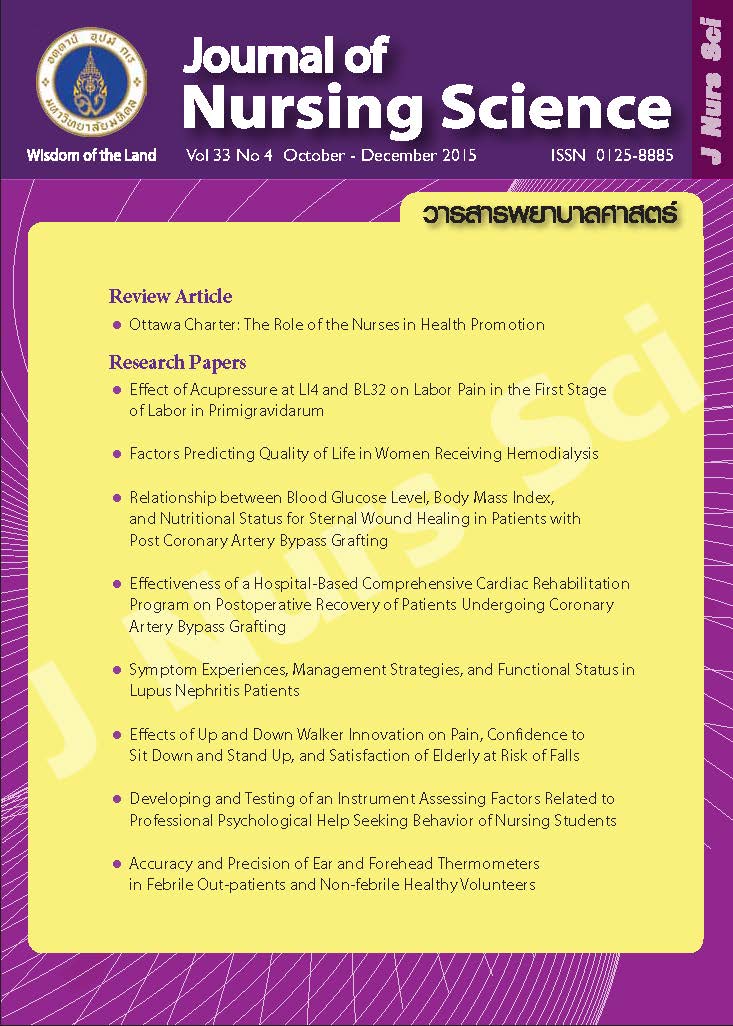Effect of Acupressure at LI4 and BL32 on Labor Pain in the First Stage of Labor in Primigravidarum
Main Article Content
Abstract
Purpose: The present study aimed to investigate the effectiveness of acupressure at the LI4 and BL32 on labor pain in the first stage of labor in primigravidarum.
Design: Experimental design.
Method: The subjects were 50 primigravida women who delivered at Charoenkrung Pracharak Hospital, during the period from May-June 2014 and randomly assigned by computer program into an experimental and a control group with 25 subjects in each group. The experimental group received acupressure at LI4 of both hands and BL32 of both sides of the sacrum for five minutes for a total period of 20 minutes, while the control group received touch without pressure being applied at the same points. Labor pain was measured by VAS before acupressure and immediately, 30, and 60 minutes after intervention. Data were statistically analyzed using Chi-square, Repeated Measures ANCOVA, and ANCOVA.
Main findings: The results showed that the average pain scores between experimental and control group were statistically significant difference (p < .05). At immediately after acupressure, and 30 minutes after acupressure, the experimental group had adjusted mean of pain scores less than control group with statistically significant, with mean difference of -15.11 (95% CI = -23.60 to -6.63; p = .001) and -12.45 (95% CI = -21.66 to -3.25; p = .009) respectively. But there was no statistic significant difference of mean score at 60 minute after acupressure (p = .109)
Conclusion and recommendations: Acupressure at LI4 and BL32 was an effective pain management method and did not cause any side effect to either mothers or fetuses in this study. Nurse-midwives who have received acupressure training may use acupressure combined with other methods in pain management during the first stage of labor.
ผลของการกดจุด LI4 และ BL32 ต่อความเจ็บปวดในระยะที่หนึ่งของการคลอดในผู้คลอดครรภ์แรก
บทคัดย่อ
วัตถุประสงค์: เพื่อศึกษาผลของการกดจุด LI4 และ BL32 ต่อความเจ็บปวดในระยะที่หนึ่งของการคลอดในผู้คลอดครรภ์แรก
รูปแบบการวิจัย: การวิจัยแบบทดลอง
วิธีดำเนินการวิจัย: กลุ่มตัวอย่างเป็นผู้คลอดที่มาคลอดที่โรงพยาบาลเจริญกรุงประชารักษ์ ระหว่างเดือนพฤษภาคม - มิถุนายน 2557 จำนวน 50 ราย แบ่งกลุ่มโดยการสุ่มด้วยโปรแกรมคอมพิวเตอร์ เป็นกลุ่มทดลองและกลุ่มควบคุม กลุ่มละ 25 ราย กลุ่มทดลองได้รับการกดจุด LI4 และ BL32 ทั้งสองข้างจุดละ 5 นาที รวมทั้งสิ้น 20 นาที การควบคุมได้รับการสัมผัสแทนการกดจุด ทำการวัดคะแนนความเจ็บปวดก่อนการกดจุด หลังการกดจุดทันที 30 นาที และ 60 นาที โดยใช้ Visual Analogue Scale (VAS) วิเคราะห์ข้อมูลโดยใช้สถิติไคสแควร์ สถิติวิเคราะห์ความแปรปรวนร่วมแบบมีการวัดซ้ำ และสถิติวิเคราะห์ความแปรปรวนร่วม
ผลการวิจัย : พบว่า ค่าเฉลี่ยความเจ็บปวดระหว่างกลุ่มทดลองและกลุ่มควบคุมมีความแตกต่างกันอย่างมีนัยสำคัญทางสถิติ p < .05 หลังกดจุดทันที และ 30 นาที พบว่ากลุ่มทดลองมีค่าเฉลี่ยความเจ็บปวดที่ปรับแก้น้อยกว่า กลุ่มควบคุมอย่างมีนัยสำคัญทางสถิติ โดยมีค่าเฉลี่ยความแตกต่างระหว่างกลุ่มเท่ากับ -15.11 (95% CI = -23.60 ถึง -6.63) และ -12.45 (95% CI = - 21.66 ถึง -3.25) ตามลำดับ แต่ไม่มีความแตกต่างของค่าเฉลี่ยความเจ็บปวดที่ 60 นาทีหลังการกดจุด (p = .109)
สรุปและข้อเสนอแนะ: การกดจุด LI4 และ BL32 เป็นวิธีการจัดการความเจ็บปวดที่มีประสิทธิภาพ และไม่พบภาวะแทรกซ้อนใดๆ ต่อมารดาหรือทารกในครรภ์ ในการศึกษาครั้งนี้ พยาบาลผดุงครรภ์ได้รับการฝึกกดจุดอาจนำการกดจุดมาใช้ในการจัดการเพื่อบรรเทาความเจ็บปวดในระยะที่ 1 ของการคลอดร่วมกับวิธีอื่นๆ ได้
คำสำคัญ: เจ็บครรภ์คลอด การกดจุด การจัดการความเจ็บปวด
Article Details
Copyright Notice: Nursing Science Journal of Thailand has exclusive rights to publish and distribute the manuscript and all contents therein. Without the journal’s permission, the dissemination of the manuscript in another journal or online, and the reproduction of the manuscript for non-educational purpose are prohibited.

Disclaimer: The opinion expressed and figures provided in this journal, NSJT, are the sole responsibility of the authors. The editorial board bears no responsibility in this regard.


